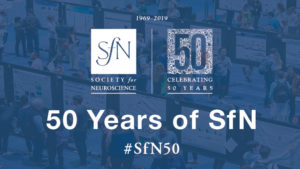Celebrating 50 years of the Society for Neuroscience
The Society for Neuroscience will go 100% virtual this year.
SfN’s mission to advancing and advocating for scientific exchange, as well as educating the public about the importance of neuroscience research.
**
While waiting to meet you in-person, we are plesed to meet you online and discuss about our latest discoveries in central nervous system disorders.
You will have the opportunity to add interesting posters to your “itinerary“, leave questions to experts and presenters. as well as reach out to other attendees.
More info about our presented topics below

ABSTRACT #1
Auditory steady-state response (40Hz) in rodents, a new tool for drug discovery in schizophrenia?
Schizophrenia is a severe psychiatric disorder associated with persistent alterations of diverse neurocognitive functions, leading to lifelong psychosocial disabilities. Although schizophrenia has long been considered as a condition that specifically impairs the higher-order functions, recent research has demonstrated that basic sensory processing is also impaired, especially in the auditory modality. Neurophysiological approaches have provided evidence that most schizophrenic patients exhibit a wide range of clinically measurable dysfunctions in the processing of auditory stimulations, including the Auditory Steady-State Responses (ASSRs)…
ABSTRACT #2
The relevance of EEG biomarker in evaluating the anti-dyskinetic effect of drugs in Parkinson’s disease
State-of-the-art clinical literature shows that motor symptoms of Parkinson’s disease (PD) result from a dysfunction of the cortico-basal ganglia circuits. A hyper synchronization of beta rhythms in this circuit, positively correlated to motor symptoms, has been characterized in both parkinsonian patients and animal models. This aberrant excessive beta oscillation is suppressed by dopaminergic treatments, which simultaneously improve motor deficits. However, a chronic L-DOPA treatment induces abnormal involuntary movements (AIMs) and a prominent resonant gamma oscillation. This project aimed at investigating the effect of the antidyskinetic drug amantadine, which is routinely used in the clinic, on L-DOPA-induced gamma oscillations in the 6-OHDA rat model of PD. In this poster, we will show that chronic administration of L-DOPA low dose (6mg/kg) induces specific gamma oscillations and AIMs which gradually increase with repeated treatments…
Related posts:
- ASENT 2024 – American Society for Experimental Neurotherapeutics
- Society for Neuroscience 2023 Congress
- Society for Neuroscience 2022 – San Diego
- ADPD 2022: EEG Biomarkers used to evaluate Anti-Dyskinetic effect of drugs in Parkinson’s Disease
- AES 2021: Partnership with OVID Therapeutics in Epilepsy
- CNS Therapeutics Xchange 2021

